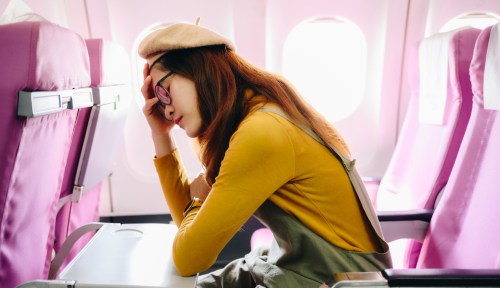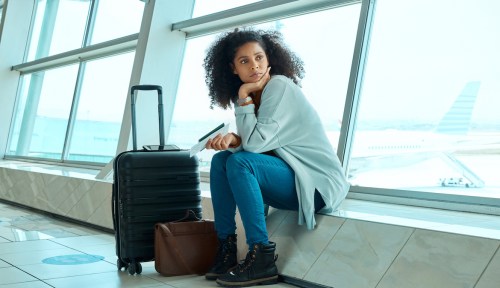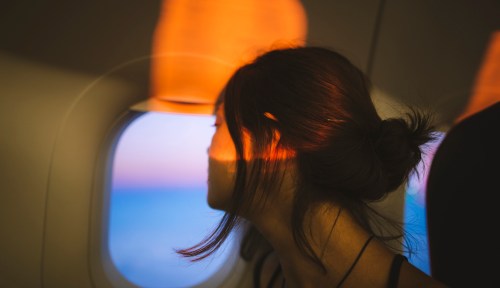We all have fears that can be tough to push through: heights, bugs, or darkness are just a few of the many things people are commonly afraid of. Flying is no exception, and it’s completely understandable why that’s the case. According to Edmund Bourne’s The Anxiety and Phobia Workbook, published in 2020, a fear of flying is the second most common phobia, with roughly eight percent of the US population reporting that they either face challenges when fly or choose not to fly altogether. Even those who don’t have a phobia of flying, aka aerophobia or aviophobia, commonly exhibit some degree of fear or discomfort when traveling in airplanes or helicopters, says Laura Wu, LCSW. The good news, though, is that this fear can usually be worked through with some time and effort.
Experts in This Article
- a trauma-informed, LGBTQ+-affirming therapist who works with teens and adults experiencing anxiety and OCD in NY and NJ
a licensed therapist who specializes in OCD and specific phobias. Laura works with individuals using a wide variety of solutions-focused modalities.
With the help of experts, we’ve put together a list of 14 tips to keep in mind next time you’re on a plane and catch that familiar feeling of worry creeping back in. Some of them might even help reduce or alleviate your fear of flying. If you know you’re prone to getting anxious before you get on a plane (or while you’re in the air, see what steps you can take in advance to make your travel time more enjoyable. (A little bit of preparation and mindfulness go a long way.)
How to stop being afraid of flying
To be clear, it’s very possible that your fear of flying won’t completely disappear, even if you follow every step on this list to a T. Though, that isn’t necessarily a bad thing. Often, the goal of working on a fear—like a fear of flying—isn’t to eliminate the phobia entirely but to learn to tolerate it when it’s happening without allowing it to become inhibiting or all-consuming. Building up your distress tolerance—or your ability to sit with the discomfort of stressful situations—is a useful skill that may allow you to enjoy all the benefits of flying, even if a bit of fear still remains.
Here are our top 14 tips to curb fear of flying:
1. Consider working with a professional
A 2014 study published by the International Journal of Travel Medicine and Global Health1 indicates that several different forms of mental health treatment can be useful in combating a fear of flying. For specific phobias (like aviophobia), Wu suggests Exposure and Response Prevention (ERP). In short, ERP involves identifying your core fear(s), the thoughts and behaviors surrounding them, and the motivations to work through them.
Once the core fear(s), thoughts, and behaviors are identified, the therapist and the client create a series of exposures that present the client with varying degrees of fear in a controlled setting. The goal of ERP, according to Wu, is to be able to tolerate feared situations by developing passive awareness of thoughts related to the core fear, rather than actively engaging with the thoughts or actively distracting yourself from them. For aerophobia, specific types of exposure might include driving to and from the airport, simulating turbulence through virtual reality, or imagining yourself on a plane with a rocky landing.
2. Identify ritual costs
Identifying ritual costs—in this case, the emotional and financial expenses that come with not flying (i.e. taking a train instead, not going on a trip, driving for long periods of time)—may increase your motivation to confront this. This process is an element of ERP treatment, but it can be useful even if you’re not engaging in ERP. It’s similar to creating a mental pros and cons list, and it can be applied to nearly all fears.
Some ritual costs that Wu often sees associated with a fear of flying are the time, effort, and (literal) costs that come from choosing not to fly. Flying is typically less time-consuming than a long drive or train trip, and it often requires less coordination and planning. Once the numbers are laid out—the amount of money spent or travel hours to take into account—you may feel more of an urge to address your fear of flying to reduce those costs.
3. Find the benefits of flying
Similar to identifying the ritual costs, pointing out the benefits of flying can be a helpful motivator in finding comfort while in the air. The specific benefits will be up to you, and they may be difficult to find at first. In this case, comparing flying to car, bus, or train travel can be a useful task. For example, flying all but guarantees that you’ll have access to a bathroom for your whole journey, and there are almost always fewer stops made than there would be on a train or a bus. Flying is also typically the fastest mode of transportation when traveling long distances, and may afford you the opportunity to sleep and eat while you’re traveling, unlike driving. These benefits don’t have to be materially specific, though. Maybe your best friend lives across the country, and learning to fly would allow you to see them more often.
4. Practice self-compassion
Every single person has at least one fear, and it’s virtually impossible to overcome a fear overnight. Working through a fear or phobia requires determination, commitment, and a willingness to adjust to varying levels of discomfort. It’s important to try as hard as you can to be kind to yourself as you go through this process. At the end of the day, you’re only human, and fear is a perfectly natural emotion. Self-compassion looks different in everyone, but a useful way to reframe your thoughts can be to talk to yourself the same way you’d speak to a friend or a loved one. The goal is not to judge, shame, or shun negative emotions, but to feel as neutral as you can towards them.
5. Stay hydrated
Consistently hydrating during a flight is super important for your mental and physical health. A 2020 study published by Nutrients (via PubMed)2 notes that planes are typically made up of cool, dry, air that is recirculated. This, along with a difference in pressure and being seated for a long period of time, can lead to physical health effects like dehydration or migraines. The good news, though, is that serious physical or mental health effects are relatively rare. To ease your mind and take the best care of your body, be sure to bring water on the plane and hydrate regularly. While liquids over three ounces typically aren’t allowed through airport security, you can bring a reusable water bottle, and many airports in the US have filtered water fountains for this exact purpose.
6. Set yourself (and your seat) up for success
Some of us prefer the access of an aisle, while others prefer to lean their head and rest against the window (and the rarest few prefer the middle seat). If you’re nervous about flying, give yourself a small sense of comfort by choosing to sit in a seat where you’ll have the most access to what you need. Each seat has its advantages: An aisle seat allows you to stand and stretch your legs (when you’re allowed to), and it provides you access to the bathroom and flight attendants without having to disrupt others. If you prefer to sleep through flights, or if it eases your anxiety to see the plane land, consider a window seat. What will feel good to you is dependent on your own preferences.
7. Be strategic about time spent at the airport
Even when airports aren’t scary, they can be stressful. Long lines and delays can compound existing fears, and almost no one enjoys being rushed. To give yourself some peace of mind, the Port Authority of New York and New Jersey recommends arriving two hours early for domestic flights and three hours early for international flights. It can also be helpful to prepare for the more stressful airport experiences: Ask a friend if you can text them as you move through the security line, or place an item tracker in your checked bag so you’ll know when it arrives at your destination. Only you know what will work best for you, but your success strategies for a train station or staying overnight at a friend’s house will most likely also apply to the airport.

8. Create comfort where and when you can
Yes, it’s true that overcoming a fear of flying essentially requires a certain degree of discomfort. That said, there’s no reason why your favorite book or coziest sweater shouldn’t accompany you on the journey. Try your best to create as much comfort for yourself as possible. Wear comfortable clothing, pack your favorite snacks, and pre-download your favorite movie, show, or podcast for the trip. If possible, you can look forward to a degree of comfort that’s provided on the plane as well. Maybe the airline provides free WiFi, or you get a free glass of your favorite soda during the drink service. That said, if all you can do once you’re on the plane is sit patiently and wait for it to be over, that’s more than enough.
9. Fly with a trusted loved one, when possible
If a friend, partner, or family member is available when you plan to fly, they may be willing to accompany you on the journey. Of course, our friends and loved ones can’t join us on every flight we take, but we can make arrangements in advance to ensure we’re only traveling when someone else is available to go with us. For example, a family reunion or a good friend’s wedding might be great opportunities to fly with others who can support you before, during, and after the flight. If you’re flying alone, watching home videos and thinking about what activities you’re looking forward to with your friends or family once you land can help distract you for those few hours that you’re in the air.
10. Identify support resources at the airport
This isn’t the case everywhere, but several airports have tools specifically designed for people with flight anxiety. For example, LAX’s PUPs are trained therapy dogs and handlers who look to alleviate the stress and anxiety that passengers are potentially feeling. This will also vary case by case, but flight attendants see passengers with a fear of flying nearly every day, and they may have some resources at their disposal to comfort you. In some cases, you could possibly meet with the captain before the flight—putting a face to the name and understanding that a trusted person is flying the plane.
11. Use past successes as reminders
Nobody has a 100% success rate at anything, but there’s usually at least one moment of growth that can be used as a reference point. You may not, and likely will not, go from an intense fear of flying to successfully taking multiple international flights, but any degree of growth is worth celebrating and acknowledging. For example, if you’re afraid to board an upcoming six-hour flight, try to think of two different three-hour flights that you successfully went on. If you haven’t gotten on a plane yet, but you drove to the airport without intense fear, or watched a movie where the characters go on a flight, that can absolutely be considered a win.
12. Try some breathing exercises
According to Wu, certain breathing exercises that encourage you to exhale for longer than you inhale can also be useful when learning to overcome a fear of flying. This is because breathing out for longer than you breathe in can activate the parasympathetic nervous system, and deactivate the sympathetic nervous system, ideally alleviating a state of anxiety. To break it down further, the sympathetic nervous system is responsible for your acute stress responses, like fight or flight, while your parasympathetic nervous system is responsible for controlling your bodily responses in a restful state.
Exhaling for longer than you inhale, when accessible, can gradually shift you back into a restful state. Dialectical Behavior Therapy suggests folks try breathing in for four seconds and out for eight, then adjust the pace based on what works for your body. It can be helpful to practice this type of breathing in nonstressful situations, so you feel well-equipped to use it when you are in anxiety-inducing situations.
13. Reward yourself when you land
One good thing about airports is that they’re stocked with food, books, and gifts. Once you land, if possible, treat yourself to your favorite snack, buy a new book to dive into on the trip home, or splurge on the taxi instead of taking public transportation if you have the means. It will give you a small dopamine rush, as well as something to look forward to while you’re on your journey. Hopefully, there are some built-in rewards upon your arrival as well. There’s no better feeling than your family’s dog running toward you, or hugging your partner after some time apart. Time spent with loved ones is one of the best ways to treat yourself after accomplishing something big.
14. Be proud of your successes
Reading through these tips alone is something to be proud of because it shows that you’re motivated to work towards achieving a challenging, but often worthwhile goal. Whether you chose to begin therapy to address your fear of flying, booked your very first airline ticket, or took a moment to celebrate the many successful flights you’ve taken so far, it’s incredibly likely that you have something to be proud of.
As you engage in the difficult, but productive work to conquer your fear of flying, remind yourself that any progress is worth being proud of. It could be helpful to have a positive accountability partner, like a friend or loved one, to remind you to celebrate your growth. Ultimately, though, this compassion and encouragement is best when it comes from you!

What causes the fear of flying?
There are many different reasons why someone could be afraid of flying, according to Wu. This is often due to a traumatic or stressful past event related to flying, but this is not always the case. A fear of flying could be passed down by a parent or caregiver who’s afraid of flying, developed through media representations of flying, or caused by an unknown source. Another possible root could be the fear or discomfort that’s elicited from not being in control—a common experience in anxiety, OCD, and phobias. For some, says Wu, not physically being in control of the plane or being at the mercy of the pilot and staff can be quite distressing. It’s also possible that another phobia could influence a fear of flying: The example Wu uses to describe this is claustrophobia or a fear of heights, both of which could cause someone to be afraid of being on a plane.
How to overcome a fear of plane turbulence
Turbulence can be a challenging thing to face, but overcoming the fear of turbulence is certainly not impossible. Wu and her colleagues have seen some success when using ButtKicker Flight Simulators, a product that simulates the feeling of airplane turbulence while remaining safely on the ground. Wu suggests pairing these with the aforementioned breathing exercises, being sure to exhale longer than you inhale, and it’s recommended that you try this in a safe professional setting. The growing field of virtual reality (VR) can also be helpful in simulating turbulence and curbing aviophobia, according to a 2017 review published by ScienceDirect3. The process is relatively new, with limited research, but Wu agrees that an excellent quality VR simulation has been successful in decreasing a fear of turbulence for some people.
How safe is it to fly?
While nothing in life is 100 percent safe, flying results in significantly fewer fatalities than highway accidents, according to the Bureau of Transportation Statistics. Data from the bureau also suggests that, between 2005 and 2022, the number of accidents, injuries, and deaths from air travel has significantly decreased. While it’s natural for the uncertainty of flying to feel a bit scary, data like this can help to remind you that airplanes are generally safe, and the chance of an accident is even rarer than it would be in a car.
The Federal Aviation Administration also has a list of airplane safety tips on their website, including safety tips specifically used when turbulence hits. The main safety suggestions are to keep your seatbelt buckled and remain attentive during the safety demonstration at the beginning of your flight. The vast majority of airplanes are equipped with a safety card that you can review at any time, life vests in case of an emergency, and oxygen masks in case there is a change in cabin pressure. Flight attendants and pilots are also specifically trained to be on alert and ready to act in an unsafe situation.
What medicine helps with flying anxiety?
You should always consult with a licensed prescriber before taking any medication, related or unrelated to flying. There are important considerations like family history, propensity to addiction, or medical conditions and allergies that doctors will factor in before choosing to prescribe a medication. The below types of medications are not recommendations and should only be taken if prescribed by a licensed medical professional.
- Benzodiazepines: These are a group of medications that are typically used to treat peaks of anxiety in the short term. Some (but not all) people with a fear of flying will take a benzodiazepine before a flight, with permission and a written prescription from their doctor. These medications are typically not meant to be taken every day.
- SSRIs/SNRIs: These are groups of medications that are used to treat anxiety and depression in the longer term. They are typically taken daily in order to be effective, and it’s important to work with a clinician who can monitor your symptoms and ensure that you’re taking the correct dosage. If the anxiety you feel is more broad-reaching and does not exclusively apply to flying, SSRIs, and SNRIs could be useful to talk to your doctor about.
Final thoughts on fear of flying
It’s completely normal to be afraid of flying, and it’s possible to overcome that fear of flying with the help of mindful behavior and guidance from a medical professional. Time, self-compassion, and exposure can all be useful tools in working up the courage to safely board a plane. Finding the treatment that works for you, following the above tips, and being patient with yourself through moments of trial and error are just a few of the ways you can work through your fear of flying. No matter where you go from here, know that you’re not alone in how you’re feeling, and don’t be afraid to lean on your support system as you navigate this.
- ↩︎
Saadat, Seyed Hassan, et al. “Non-Pharmacologic Treatments for Fear of Flying.” International Journal of Travel Medicine and Global Health, vol. 2, no. 1, Mar. 2014, pp. 31–37, www.ijtmgh.com/article_33274.html. Accessed 31 Aug. 2024.
- Zubac, Damir et al. “Up in the Air: Evidence of Dehydration Risk and Long-Haul Flight on Athletic Performance.” Nutrients vol. 12,9 2574. 25 Aug. 2020, doi:10.3390/nu12092574↩︎
- ↩︎
Cardoş, Roxana A.I., et al. “Virtual Reality Exposure Therapy in Flight Anxiety: A Quantitative Meta-Analysis.” Computers in Human Behavior, vol. 72, July 2017, pp. 371–380, https://doi.org/10.1016/j.chb.2017.03.007.
Sign Up for Our Daily Newsletter
Get all the latest in wellness, trends, food, fitness, beauty, and more delivered right to your inbox.
Got it, you've been added to our email list.











